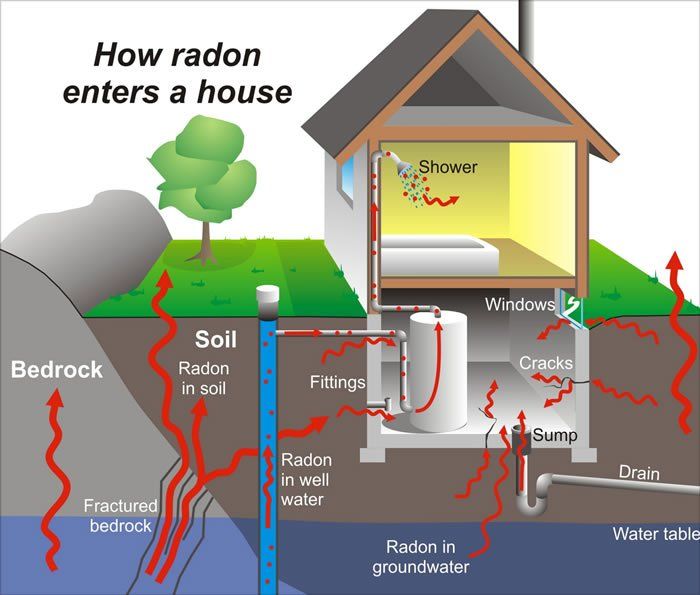Radon
About
Radon is an invisible and odorless radioactive gas. It is produced by the natural decay of uranium that is found in nearly all soils. Radon is harmful to humans and known to cause cancer. It can only be detected through radon testing. According to the EPA, nearly 1 our of every 15 homes in the U.S. has elevated radon levels.
Radon typically enters through
- Cracks in solid floors
- Construction joints
- Cracks in walls
- Gaps in suspended floors
- Gaps around pipes
- Cavities inside walls
- The water supply
View Introduction to Radon presentation [PDF] from MDPH’s Senior Technical Radon Specialist, Lisa Hébert.

Risks
Radon is known to cause lung cancer. According to the EPA, radon is responsible for 21,000 lung cancer deaths each year. It is the number one cause of lung cancer among non-smokers and the second overall. Smokers who are exposed to radon have a significantly higher risk of lung cancer.
There are no early symptoms of radon exposure, and there is no easy way to test individuals for exposure. The best way to protect you and your family is to test your home.
Solutions
Test your home
- Test your home yourself by using a 2-day test kit or 90-day test kit. 90-day test kits are more accurate. Be sure to follow the instructions closely.
OR
- Hire a professional to test for radon for you. The Massachusetts Radiation Control Program’s Radon Unit may be able to offer guidance and assist you with the process.
If you have unacceptable levels of radon, fix your home
Radon is measured in picoCuries per liter of air (pCi/L). While no level of radon is safe, radon levels below 4 pCi/L are considered acceptable. If your home has radon levels above 4 pCi/L, you should take action.
- Contact the state radon office for guidance and assistance .
- Hire a trained professional contractor who has the technical knowledge to choose the correct treatment method to address the issue.
- Be sure to re-test your home after repairs are complete to make sure the problem is fixed.
Tips to Reduce the Risks of Radon Exposure
- Keep your home ventilated by opening windows and using fans and vents to circulate air. (This will only temporarily reduce radon levels.)
- Seal cracks in floors and wall with plaster, caulk or other crack sealants.
- You can cover the earth floor in crawl spaces with a high-density plastic sheet. A vent pipe and fan can be used to blow the radon from under the sheet and vent it to the outdoors
- Don’t smoke inside as this will increase your risk of lung cancer from radon.
Radon Services and Resources
- Information, Technical Assistance, & Test Kits (when available), MA Department of Public Health Radon Program, Western Regional Health Office - 413-586-7525
- Get live help for your radon questions, National Radon Hotline 1-800-55RADON (557-2366), EPA
- For general information on fixing or reducing the radon level in your home, National Radon Fix-It Hotline 1-800-644-6999, EPA
- Search for Radon Mitigation Specialists, AARST-NRPP
- "A Citizen’s Guide to Radon: The Guide to Protecting Yourself and Your Family from Radon", EPA
- "Consumer’s Guide to Radon Reduction: How to Fix Your Home", EPA
- "A Radon Guide for Tenants", EPA
- Radon, Mass.gov
- Radon is a health hazard with a simple solution, EPA
- About Radon, HUD




